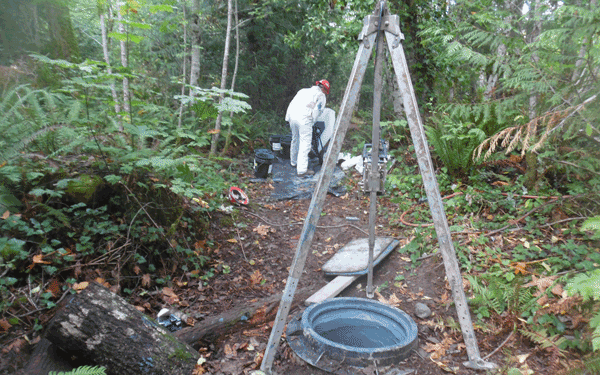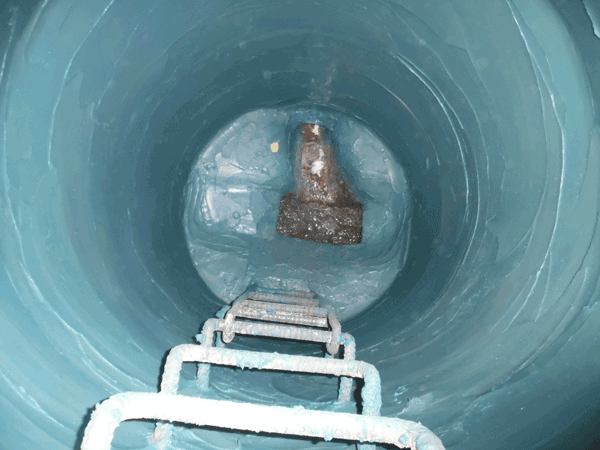If a concrete manhole fails in a forest and no one is around to hear it, does it still make an impact?
Fortunately for the residents of Bremerton, Washington, located just across the Puget Sound from Seattle, the city’s proactive public works department was not willing to find out. Faced with two precast manholes in a heavily wooded area that needed rehabilitation, the city worked with nearby contractor Pro-Vac to find an immediate solution.
“It was out in the jungle, so to say,” explained Hank Celigoy, grouting manager at Pro-Vac. “It was absolutely the worst part of town. They were about 50-feet [15.2 m] off pavement in a wooded area, near a hiking trail.”
“But there weren’t any traffic conditions to deal with, so that part was nice,” Celigoy added.
Sewer Line Corrodes Manhole
Nonetheless, the two manholes — one 6 feet (1.8 m) deep by 4 feet (1.2 m) in diameter, the other 10 feet (3.0 m) deep by 4 feet (1.2 m) in diameter — were of considerable importance to the city because of their location directly above a main sewer line.
“I knew that line,” Celigoy said. “There's a lift station right below it, and any time you pump a sewer, it creates hydrogen sulfide [H2S] gas.”
Because of that dynamic, H2S had slowly corroded the manhole since its original construction in the 1970s, Celigoy estimated. By the time Pro-Vac’s three-person crew arrived at the scene in early December 2016, the effects of corrosion were quite evident.
“It was quite worn,” Celigoy said of the manholes. “The rocks and aggregate were really showing, so we knew we’d use a bit more product than usual, since we needed to get everything covered.”
Solution Needed for Wet Conditions
Based on prior related work, the Pro-Vac team believed CLADLINER — a high-build, hybrid epoxy liner system — to be an ideal choice for this job, based on its high chemical resistance and anti-microbial performance.
Designed for use in the wet, humid conditions found in manholes, the product is made of 100-percent solids with no volatile organic compounds (VOCs), thus eliminating environmental concerns.
The product can also be used as both a resurfacer and liner in one application, and that efficiency was key in allowing the Pro-Vac team to complete the job in just one day. With the holidays around the corner, time was at a premium for all involved.
Digging Into the Project
With that in mind, the crew got to work early on a cold December morning in the Pacific Northwest, wearing ventilators, face masks, safety glasses, hard hats, rubber boots, rubber gloves, and Tyvek coverall suits as personal protective equipment (PPE).
Based on the confined space inside the precast concrete manholes, gas monitors, safety harnesses, and a tripod were also used as extra safety precautions, Celigoy explained. National Safety, Inc., based in nearby Kent, Washington, supplied all PPE and safety equipment.
To begin the job, both manholes were pressure washed with a 5,000-psi (34.5 MPa) Honda washer to remove any loose material from the walls and base. For purposes of efficiency, the crew simultaneously used a blower to dry the first manhole while pressure washing the second.
“You can stick your hand on it and know if it’s dry or not,” Celigoy explained. “It’s not just about heat [from the blower], but also the air.”

But since the CLADLINER system can work in humid environments, complete dryness was not a prerequisite. Rather, the pressure washing and blower primarily served to remove any loose material. As a result, it only took several hours for the surface to be sufficiently prepped for the application of the hybrid epoxy liner system.
“One of the many positive features of CLADLINER is that it can be applied the same day as the pressure washing, because moisture doesn’t affect its curing,” said Scott Bevens, owner of Superior Supply LLC in nearby Portland, Oregon. Bevens’ company supplied the liner system to Pro-Vac for this particular project.
With the surface prepared, the CLADLINER was mixed in the bucket it was shipped in using a hand-held, 0.5-inch (1.3 cm) drill and paddle mixer. The product was then poured into the hopper of a Graco Toughtek S340E pump — a plural-component system — and sprayed onto the walls of the manholes at a thickness of 250 mils (6,350.0 microns).
“The best thing to do is hand mix it, dump it in the hopper, and go,” Celigoy explained. “And the pump is so light that it really wasn’t a problem to get it out there [to the remote location].”
From there, the crew’s finishing touch involved the use of 4-inch (10.2 cm) hand brushes and a cement trowel to polish the CLADLINER to a smooth finish.
“You just want to make sure it’s flat,” Celigoy said. “At that point, it’s done, and the stuff really hardens in just five or six hours.”
Successful Job Builds Trust
As a result, the manhole was ready for the city’s use by the very next business day!
“They said they were very pleased,” Celigoy said. “So far, so good. You couldn’t pick two better manholes.”
Similarly, the Pro-Vac manager offered kind words for the city’s willingness to invest in not just the rehabilitation of the manholes but to use a more advanced solution.
“Me and [the manager] have known each other for 20 years,” Celigoy said. “We’ve known each other for a long time, so there’s mutual trust. That’s big. If I tell him there’s something new on the market, he’s willing to try it.”
For Pro-Vac, the hope is that the successful completion of the most recent job will lead to even more rehabilitations in the future — particularly considering the unique geographical challenges of the Puget Sound area.
“It’s basically a beach on the Sound,” Celigoy said of the area. “A lot of infrastructure is stuck in sand, and it’s tough to get to. And the manholes themselves are a full-time job. People are starting to realize the importance.”
And with positive feedback like the reception from Bremerton officials, his team knows they’re in a strong position to get many of those calls.
“They’ve already told me they’ve got two more they need to do,” Celigoy said. “That’s all you want to hear!”
